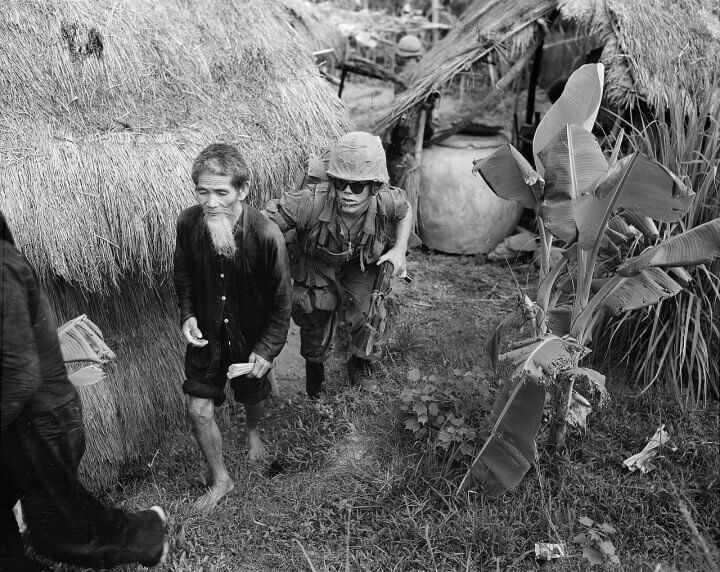The Vietnam War is also known in Vietnam as the Resistance War against America. Additionally, it is referred to as, The Second Indochina War. The war took place in Laos, Cambodia, and Vietnam, beginning in 1955 and continued until Saigon fell in 1975. It lasted nearly 20 years!
- The Great Cold War:
After World War II, most of the world was divided into two camps: the communist allies (China, Soviet Union, North Vietnam, East Germany), and the anti-communist allies (United States, Great Britain, France, West Germany, Philippines). This division kept a “cold war” brewing for nearly 50 years. Vietnam was divided into two regions: North Vietnam and South Vietnam. The North was supported by the communist allies and the South was supported by the anti-communist allies. There was great fear that South Vietnam would fall into hands of the communists. The U.S. practiced a policy of containment, in which they were attempting to stop the spread of communism. They viewed the threat of communism to be a threat to national security. This created tensions throughout the world.
- Viet Cong and the North Vietnam Allies:
The Viet Cong or the National Liberation Front were both a political organization and an army with ties to the North Vietnamese. The Viet Cong had its own army and used guerilla tactics to lead the resistance against the South Vietnamese and their allies. Eventually, the resistance would prove to be a worthy opponent to South Vietnam.
- Three Million Died, Including 58,000 Americans in the Vietnam War.
The Vietnam War was an expensive war that lasted nearly 20 years. Not only was the cost of the war astronomical, the fact that 3 million people died in the war, including 58,000 Americans, is staggering. Additionally, 150,000 were injured and 10,000 went missing in the war.
- The Costly War:
The Vietnam War is the longest war the United States has ever been involved in. The war was an unpopular war with the people at home in the United States. Due to the unpopularity of the war, veterans of the war were often mistreated when they returned home. Many believed that the United States should never have gotten involved in the conflict. The war in Vietnam was considered a civil war by some, in which case, it followed that the United States did not belong in the conflict.
- War or Conflict?
The United States never declared war on North Vietnam. Technically, it was actually a conflict, rather than a war. It has been argued that the Vietnam War had very little to do with Vietnam at all. In fact, the conflict could be considered a war by proxy between the United States and the Soviet Union. The United States policy of containment caused constant tensions between the two countries, leaving other regions, such as Vietnam, Laos, the Philippines, and Cambodia in the middle.
- Colonialism and Imperialism in Vietnam:
In ancient times, Vietnam was under the rule of China. Then, in the 1800’s, France conquered Vietnam and established the territory as French Indochina. During the 20th century, a sense of nationalism grew throughout Vietnam and attempts to diminish French influences began to emerge.
- Ho Chi Minh and Viet Minh:
Ho Chi Minh was a communist party leader of North Vietnam. Ho Chi Minh was born in Vietnam. Soon after World War, Ho Chi Minh was a young man, living in France. He became interested in Vietnamese independence and was inspired by the Bolshevik Revolution. He traveled to the Soviet Union and joined the communist party. While living in France, Minh organized other Vietnamese and petitioned the government of France to grant equal rights. In 1930, Minh was one of the founding members of the communist party in Vietnam. In 1941, Minh helped to found the Viet Minh, also known as the League for the Independence of Vietnam. After World War II, Minh saw the opportunity for Vietnamese independence and worked his entire life to this cause.
- Leaders During the Vietnam War :
The Vietnam War lasted throughout five presidencies. The presidents were: Dwight Eisenhower, John F. Kennedy, Lyndon Johnson, Richard Nixon and Gerald Ford. In 1963, John F. Kennedy was shot and Lyndon B. Johnson was the succeeding president. Three weeks before the assassination of President Kennedy in the United States, South Vietnam President Ngo Dinh Diem and his brother Ngo Dinh Nhu (who was also one of Diem’s most powerful advisors) were brutally murdered. These events had an important impact on the outcome of the Vietnam War.
- Who Fought in the War?
About 70% of the military in the Vietnam War volunteered for military service. The remaining 30% of Americans men that fought in the Vietnam War were drafted. The draft was conducted by way of lottery. On December 1, 1969, two lotteries were drawn for military service. Those included in the draft were those with birthdates between the years of 1944-1950. Those that were drawn on that date were used for the calendar year of 1970. The utilization of the draft further increased the public objections to the war.
- The Nixon Doctrine:
During the end of Lyndon B. Johnson’s presidency, the Vietnam War was beginning to de-escalate. In 1969, United States President Richard Nixon began the withdrawal of troops in Vietnam. Anti-war sentiments and public outrage about events in the war were impossible to ignore in the United States. Nixon began to pursue détente with the Soviet Union and relations with China had improved.


Leave a Reply